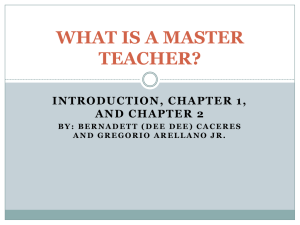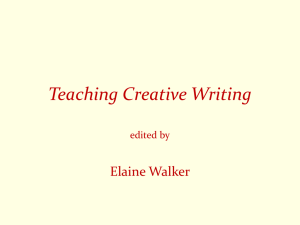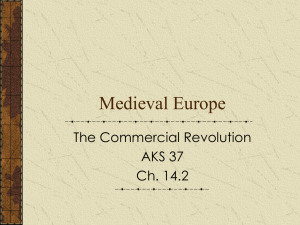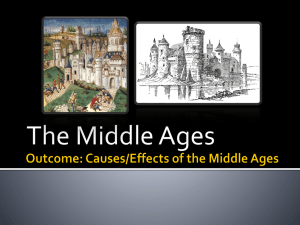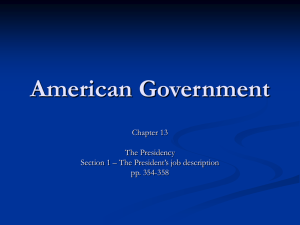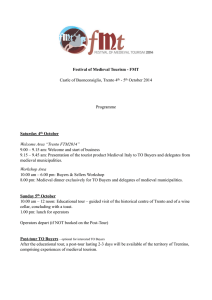Working in a Guild - College of Business and Economics
advertisement
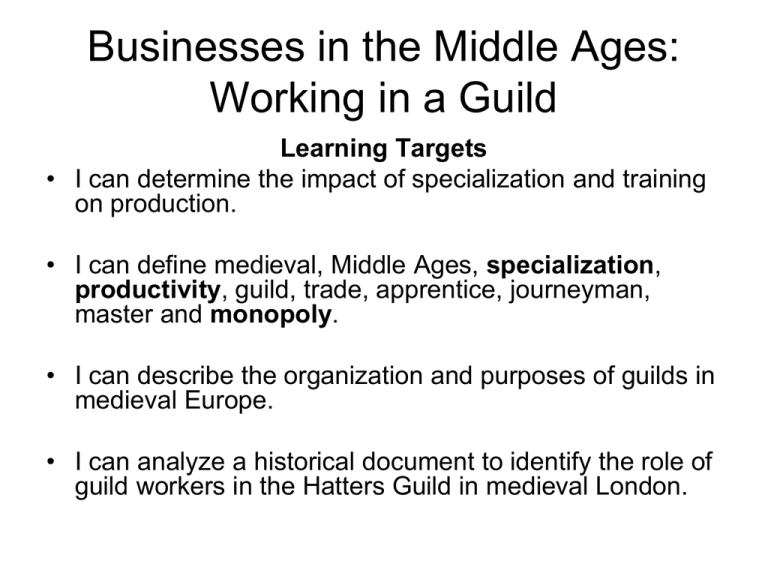
Businesses in the Middle Ages: Working in a Guild Learning Targets • I can determine the impact of specialization and training on production. • I can define medieval, Middle Ages, specialization, productivity, guild, trade, apprentice, journeyman, master and monopoly. • I can describe the organization and purposes of guilds in medieval Europe. • I can analyze a historical document to identify the role of guild workers in the Hatters Guild in medieval London. Lesson 16- BIG Picture Time Required/Recommended: – One 45 minute session for the production activity. – One 30 minute session for analyzing the historical document. Outside Materials Needed: – Two sheets of newspaper for each student – Several rolls of tape Terms You Will Review or Learn Historical Terms • • • • • • • Medieval Middle Ages Guild Trade Apprentice Journeyman Master Economics Terms •Specialization •Productivity •Monopoly LESSON 16 – BUSINESS IN THE MIDDLE AGES: WORKING IN A GUILD FOUR IMPORTANT DEFINITIONS: #1 Medieval: Relating to the Middle Ages. The Middle Ages are often dated from the fall of the Roman Empire in the 5th century C.E. to the beginning of the Renaissance in the 15th century. FOCUS MIDDLE SCHOOL WORLD HISTORY © COUNCIL FOR ECONOMIC EDUCATION, NEW YORK, NY LESSON 16 – BUSINESS IN THE MIDDLE AGES: WORKING IN A GUILD FOUR IMPORTANT DEFINITIONS: #2 Guild: A business group formed by workers in the same occupation to promote their interests. Guilds were common in medieval Europe between the 11th and 16th centuries. Carpenters, weavers, painters, goldsmiths, hat makers, and many other types of workers formed guilds. FOCUS MIDDLE SCHOOL WORLD HISTORY © COUNCIL FOR ECONOMIC EDUCATION, NEW YORK, NY LESSON 16 – BUSINESS IN THE MIDDLE AGES: WORKING IN A GUILD FOUR IMPORTANT DEFINITIONS # 3 Specialization: A situation where people produce a narrower range of goods and services than they consume. Guilds involved specialization, since guild workers only produced one type of product. Specialization allows people to increase their productivity. FOCUS MIDDLE SCHOOL WORLD HISTORY © COUNCIL FOR ECONOMIC EDUCATION, NEW YORK, NY LESSON 16 – BUSINESS IN THE MIDDLE AGES: WORKING IN A GUILD FOUR IMPORTANT DEFINITIONS # 4 Productivity: The productivity of a worker refers to the output for a worker in a certain time period, such as an hour or a day. FOCUS MIDDLE SCHOOL WORLD HISTORY © COUNCIL FOR ECONOMIC EDUCATION, NEW YORK, NY Answer Me This… • How might specializing in something allow each worker to increase his or her productivity? • For instance, how might a worker who specialized as a weaver be able to weave more cloth in a day than someone else? A person who specializes in weaving would have more practice and better skills and would know how to weave faster. Why did workers in cities organize themselves into guilds? • You are going to become a hatter, in order to find out! Rules For Hat Making • • • • Quality is important! No talking No working together Keep your eyes on your own work Hat Standards • How did you know the standards for your hat? • How well will the completed hats hold up in today’s weather? • How many hats did we make? How is the quality? • Volunteer- Let’s collect those hats! Why did workers in cities organize themselves into guilds? Let’s find out a bit more about guilds… LESSON 16 – BUSINESS IN THE MIDDLE AGES: WORKING IN A GUILD GUILD ORGANIZATION: Apprentices An apprentice was a young person (most often male) who worked for a guild master while learning a trade. Apprentices often began at age 12 and were given room and board at the master’s house, but earned no money. Apprenticeships could last for 2–7 (or more) years. FOCUS MIDDLE SCHOOL WORLD HISTORY © COUNCIL FOR ECONOMIC EDUCATION, NEW YORK, NY LESSON 16 – BUSINESS IN THE MIDDLE AGES: WORKING IN A GUILD GUILD ORGANIZATION: Journeymen After finishing the apprenticeship, the worker could become a journeyman. Journeymen, or day laborers, were paid wages by the day while working in the trade. FOCUS MIDDLE SCHOOL WORLD HISTORY © COUNCIL FOR ECONOMIC EDUCATION, NEW YORK, NY LESSON 16 – BUSINESS IN THE MIDDLE AGES: WORKING IN A GUILD GUILD ORGANIZATION: Masters A master (or master craftsman) was a full member of the guild and could start his own business. To become a master and a full member of the guild, journeymen sometimes had to produce a “masterpiece” in their trade. If the masterpiece was accepted by the guild members, they could vote to accept the journeyman as a master in the guild. It was an honor to be a guild member. Some masters were chosen to be inspectors to make sure that other guild members’ products were of a high standard or quality. FOCUS MIDDLE SCHOOL WORLD HISTORY © COUNCIL FOR ECONOMIC EDUCATION, NEW YORK, NY Benefits of Belonging to a Guild • What might be some benefits of belonging to a guild? Welcome Apprentices to the Hatters Guild of London! Watch carefully as I demonstrate how to make one of these lovely hats. Masters teach groups Two minutes to complete your hat Ask questions of your master and each other Masters’ Quality Report How many hats meet the standards of the Hatters Guild? Were more “good” hats made this time? Masters, share a few comments on quality Who Benefits From Quality? Quality, Quality, Quality How do consumers benefit? How do producers benefit? LESSON 16 – BUSINESS IN THE MIDDLE AGES: WORKING IN A GUILD SOME PURPOSES OF GUILDS • Provided training for apprentices to learn to make the product. • Provided day labor and wages for journeymen. • Set standards for the quality of the goods produced. • Established a monopoly and restricted competition in the trade occupation. - A monopoly is when there is only one seller of a product. If a guild had a monopoly, it could set a higher price than it could with competition. FOCUS MIDDLE SCHOOL WORLD HISTORY © COUNCIL FOR ECONOMIC EDUCATION, NEW YORK, NY LESSON 16 – BUSINESS IN THE MIDDLE AGES: WORKING IN A GUILD SOME PURPOSES OF GUILDS • Gained influence over local governments to be able to promote the interests of the guild members. • Provided for the families of guild members in case of illness or death. • Encouraged religious living following Christian practices. FOCUS MIDDLE SCHOOL WORLD HISTORY © COUNCIL FOR ECONOMIC EDUCATION, NEW YORK, NY How do historians know what happened in the past? • Primary Source Document: “The Rules of the Hatters of London” -What were the rules? • As a group, answer questions 1-6 Let’s Compare and Contrast 1. What powers did the mayor of London have in 1347? -The mayor had the power to approve the Hatters Guild’s rules. Also, defective hats were brought before the Mayor and he appears to have been in charge of punishing those who caused defects. Let’s Compare and Contrast 2a. What was the role of the wardens in the Hatters Guild? -The wardens “rule and watch the trade.” They examine all the hats for sale in the area and have the power to bring defective hats before the Mayor. 2b. How did someone get to be warden in the Hatters Guild in London in 1347? -If you were one of six of the most lawful men of the trade, you could be assigned to be a warden. Let’s Compare and Contrast 3. How long would someone be an apprentice in the Hatters Guild of London in 1347? -7 years Let’s Compare and Contrast 4. Why is there a rule saying that “no workman in the trade shall do any work by night, but only in clear daylight”? -Rule 6 says that some workmen have made hats that are not of high quality, and this has caused “…scandal, shame and loss to the good folks of the hatters trade.” Therefore, if hats can only be made in daylight, the wardens can inspect the work. Let’s Compare and Contrast 5. What evidence is in the document that some people in London were not free in 1347? -Rule 2 says that no one can make or sell hats in London if he is not free [and from London]. Rule 4 says that no one in the hatters trade can take an apprentice if he is not a freeman of London. If you took an apprentice for less than seven years, you would lose your freedom and have to buy it back. The third time a workman is caught working at night, he loses his freedom. Let’s Compare and Contrast 6. What are some of the punishments that existed in Lpondon in 1347 for not following the riles of the Hatters Guild? - Rule 2:Give up the ahts he made or was selling; Rule 3: lose freedom until he buys it back; Rule 6: pay a fine to the Guildhall and lose one’s freedom. Let’s Review Key Terms Historical Terms • • • • • • • Medieval Middle Ages Guild Trade Apprentice Journeyman Master Economics Terms •Specialization •Productivity •Monopoly Making Connections 1. How did the guild system increase worker productivity? 2. Why did guilds result in higher quality products? 3. Why did guilds result in higher prices?
